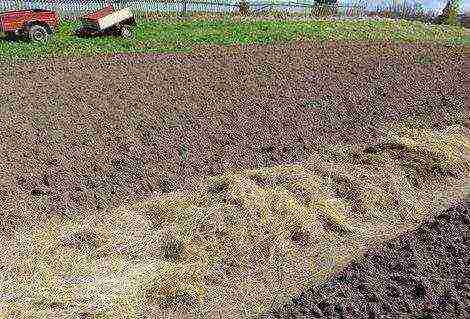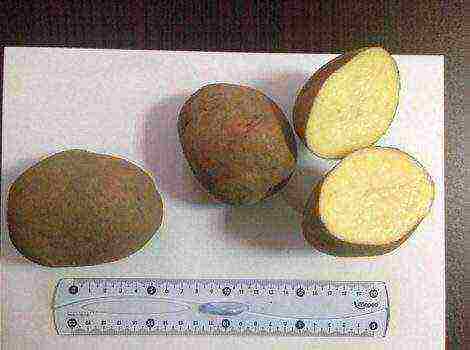Content
What is a potato tuber
When potato growers speak of a seed, they mean a tuber, a vegetative seed, not a botanical one. The potato tuber is a modified stem with 70-75% water content and the remaining 25-30% dry matter. It has buds from which new growth begins.
What is a potato tuber
A tuber is a part of a plant that plays role in year-round vegetation... As a store of energy and nutrients, it serves to restore growth during the next growing season and as a means of asexual reproduction.
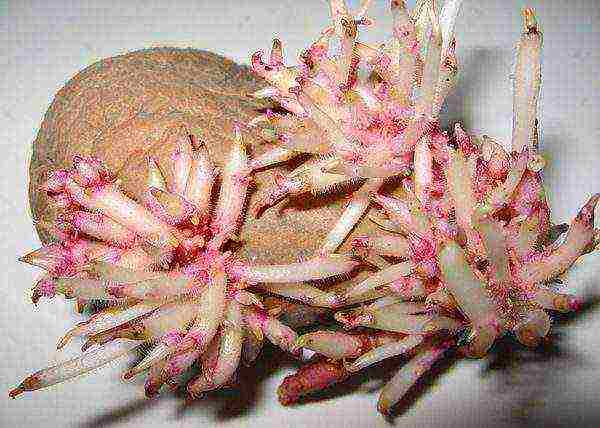
Strictly speaking, this is the top of an underground stem, called the rhizome, which swells with nutrients.
The plant uses the stored energy to support new shoots, thus ensuring the survival of the species. Helps the plant gain a foothold in the soil, just like the roots do.
Tuber definition
A potato is a stem tuber with parts of a normal stem (including nodes called buds or eyes) and internodes. In structure, each node has a leaf trail, is able to germinate and develop into a new stem.
The plant is grown from whole and cut potatoes, and the number of stems obtained from a planted specimen is depends on the number of eyes and its physiological age.
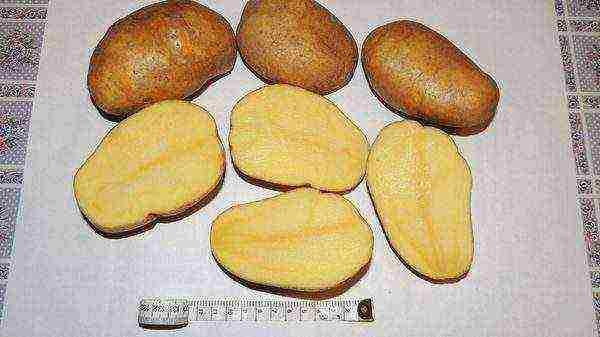
The buds are arranged in a spiral, starting at the end opposite to the point of attachment to the stolon. The terminal bud appears at the furthest point from the stolon attachment, showing apical dominance like a normal stem.
Inside, the tuber is filled with starch stored in an enlarged cell-like parenchyma. The inner part has a cellular structure typical for any stem (core, vascular zones and cortex).
How tuber is formed
Stem tuber formed from thickened rhizomes (underground stems) or stolons that develop from the lower leaf axils on the stem and grow into the soil.
The stolon lengthens over long days in the presence of high levels of auxins, which prevent stolon root growth. Before the new formation of potatoes begins, the stolon must be of a certain age.
Leaves, as the plant grows, produce starch, which is transported to the ends of underground stems (stolons). They thicken, forming several tubers located closer to the soil surface.
They swell when the plant begins to invest in them most of its resources. Tuber formation ends when the soil temperature reaches 27 ° C. Potatoes are considered a cold season crop.
Pests and diseases
Late blight
Remains a major problem for potatoes. A disease caused by the phytophthora filamentous organism, Phytophthora infestans, spreads rapidly in foliage and potatoes. In temperate regions, soil or plant debris harbors the pathogen between seasons.
It survives in infected specimens that remain in the soil since last season... The seed pieces can also be infected and contain the pathogen. When new shoots emerge from infected seeds, the fungus infects and then sporulates on the new growth.
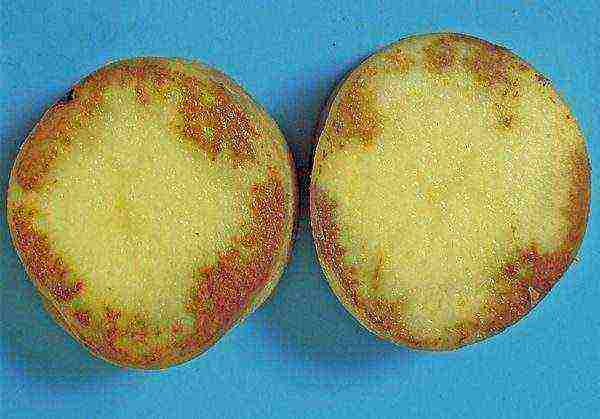
Sporangia
Microscopic, asexual spores that the pathogen produces. Under favorable environmental conditions, they spread by air or water. They land on foliage and, at low temperatures and sufficient humidity, form and release zoospores that migrate over the wet leaf surface.
Each zoospore germinates over time under the specified conditions and sends the germ tube into the leaf tissue. Penetrating into the epidermis in several areas, it causes small brown spots. They quickly expand into large rots.
Common scab
Infection of potatoes with phytopathogenic Streptomyces scabies. Signs of infection appear on surfaces with cork formations brown, irregular in shape, up to several millimeters in diameter.
The disease does not affect the yield, although it reduces its quality. Infected potatoes are edible, flesh quality and flavor similar to healthy ones. The common scab is caused by a lack of water when growing the plant.
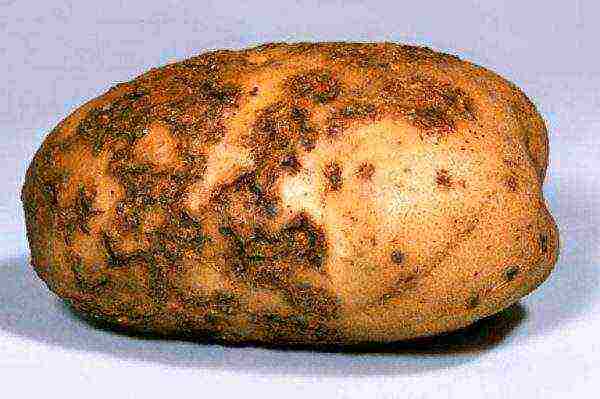
Silver scab
Caused by the pathogenic Helminthosporium solani. Light brown spots appearing on the tuber change the permeability of the skin, which leads to shrinkage and loss of water. The ideal conditions for the spread of the disease are high temperatures and high humidity.
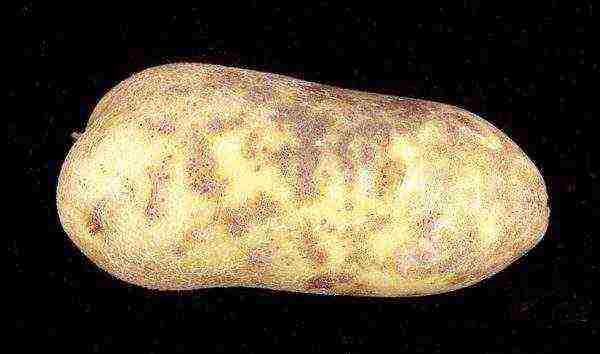
Powdered scab
Caused by the pseudo fungus Spongospora subterranea f. sp. Signs include minor damage (white growths) at an early stage of the diseaseprogressing to light pustules (wart-like) on the surface of the tubers.
With maturation, they become embossed, crack, forming ulcers filled with a brown powdery mass.
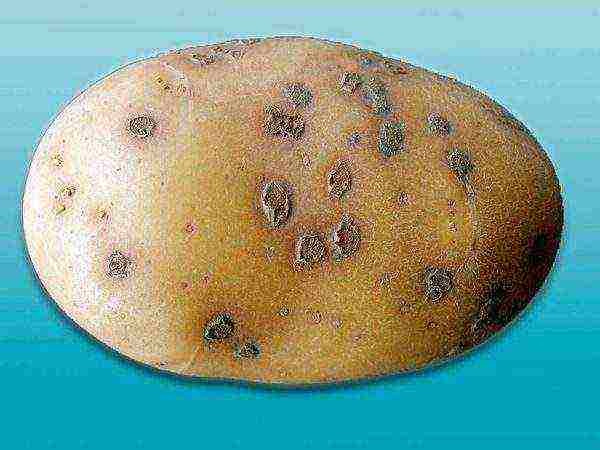
Oosporosis or lumpy scab
The causative agent is the ascomycete fungus, Polyscytalum pustulans, which affects the eyes on the seed tubers.

Pests
Insectstransmitting potato diseases and damaging the plant:
- Colorado beetle;
- potato moth (fluorimea);
- big aphid;
- nematode.
- Colorado beetle
- Fluorimea
- Potato aphid
- Nematode
Potato structure
Potatoes are a herbaceous perennial plant that grows up to 100 centimeters depending on the variety. Leaves die off after flowering, fruiting and tuber formation. The flowers are white, pink or purple with yellow stamens (the skin of the tubers depends on the color of the flower).
Culture mostly cross-pollinated by insectsbut also self-pollinates. As a rule, the signal for the formation of tubers is a decrease in the length of daylight, but in commercial varieties this tendency is minimized.
Potatoes include:
- ground part of the plant (or tops): a branching bush consisting of several stems (from 4 to 8);
- leaves dark green, intermittent—unpaired—cirro—dissected, located spirally on the stem. Each leaf is represented by a middle vein (axis), pairs of lateral opposite lobes, between which there are lobules and, in turn, lobules between them (the number depends on the age of the leaf), an unpaired lobe is located at the top of the leaf;
- bisexual flowers and possess the main parts: calyx, corolla, male element (staminate) and female element;
- stolonsforming adventive roots at the nodes, and new plants from the buds.
What fruits does potato form
As it fades, the plant produces small green fruits that resemble green cherry tomatoes. Plants propagating from tubers are clones of the parents.
New varieties are grown from seeds, which are then propagated vegetatively. Fertile fruits contain more than 200 potato seeds in tetraploid varieties.
Root crops, rhizomes, tubers, root tubers belong to the root systemthey should not be confused with fruits. In botany, true roots (root crops and root tubers) are distinguished from non-root (tubers, rhizomes).
| Root vegetable | a plant organ enlarged to store energy in the form of carbohydrates;
associated with the root system (as the first part of the name suggests), is not a fruit (the second part of the name is incorrect from a biological point of view) |
| Rhizome | modified underground plant stem with adventitious roots, rudimentary leaves, and axillary buds |
| Tuber | a shortened shoot modified to store energy (carbohydrates) or water |
| Root tuber | thickening of the roots (main or adventitious) as a result of the deposition of nutrients for the reserve |
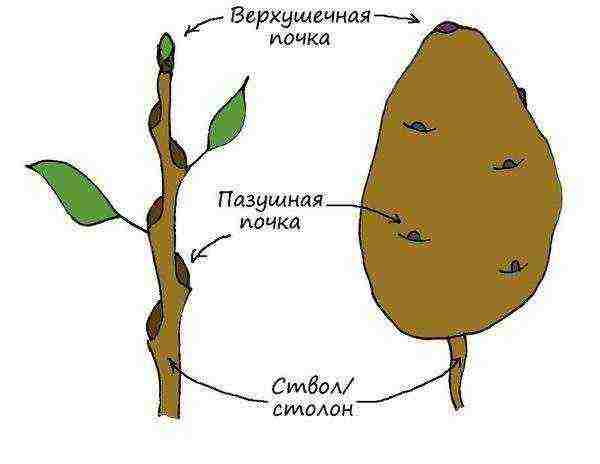
The stolon is similar to the rhizome, but, unlike it, it is the main stem of the plant. Shoots from a stolon develop from an existing stem, have long internodes, and form new shoots at the end.
Biological features of culture
From planting to ripening, the period ranges from 80 to 150 days, depending on the varieties. The life cycle of a potato is characterized by initiation and growth followed by a dormant period and finally germination leading to the next vegetative generation.
Germination start after a period of rest, it is accompanied by an increase in cellular metabolism. Seedlings emerge from the buds (eyes).
Following formed all vegetable parts... Photosynthesis takes place. The first and second stages last from 30 to 70 days, depending on the date of planting, soil temperature and other environmental factors, the physiological age of the tubers and the characteristics of specific varieties.
Tuber formation occurs approximately 30-60 days after planting the seed tubers, from lateral subsoil buds developing at the base of the main stem, which, when underground, develop into stolons due to diagravitropic growth.
When conditions are favorable for the initiation of tubers, the elongation of the stolon stops, and the cells located in the core and cortex of the apical region of the stolon first expand and then divide longitudinally.
The combination of these processes leads to swelling of the subapical part of the stolon. This phase is associated with flowering (but not always).
In the process of expansion tubers store carbohydrates (mainly starch) and proteins. By reducing overall metabolic activity, they behave like normal storage vessels.
Tubers are harvested from 90 to 160 days after planting, depending on varieties, production area and marketing conditions. Starch usually makes up 20% of the fresh weight of a ripe tuber.
After potato vines die off, the skin of the tuber thickens and hardens (sugars turn into starch), which provides more protection for the tubers during harvest, including blocking the penetration of pathogenic microorganisms into them.
Although the dormant period is determined by the absence of visible growth, dormant meristems remain metabolically active, only the rate of many cellular processes is suppressed.
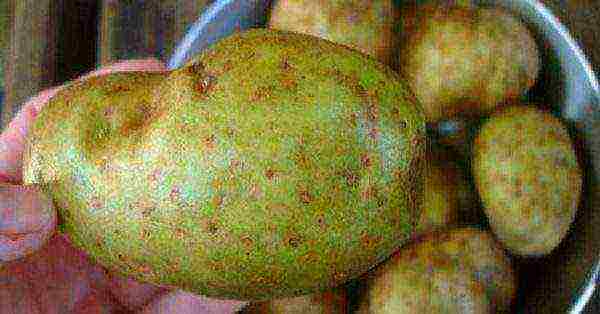
Chemical composition and nutritional value of potatoes
The tuber contains on average about 78% water, thus only the remaining 20% have direct nutritional value... Carbohydrates (18.4%) are the most abundant nutrients in potatoes, represented by starch and some soluble carbohydrates, dextrose and sugar.
Young tubers have a high proportion of sugars and less starch. But the longer it is in the soil, the more the starch content increases. As it germinates, some of the starch turns into soluble glucose.
Sometimes you can hear that potatoes are indigestible due to their high cellulose content. In fact, such criticism has no basis. The cellulose content is less than 0.5%, as in many cereals and vegetables.
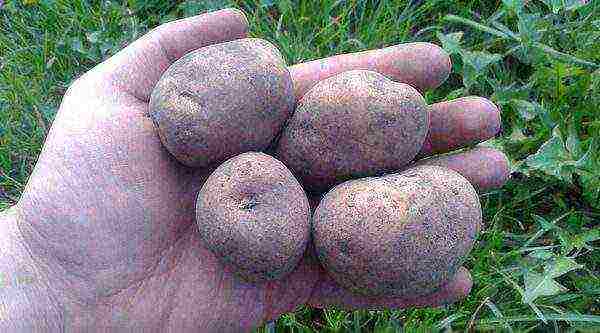
Fat or ether extract appears in small quantities, it can be practically ignored when discussing nutritional value, especially since most of it is in the inedible peel in the form of a wax-like body.
Potato proteins are classified into three groups: patatin, protease inhibitors, and high molecular weight proteins. The glycoprotein patatin makes up about 20% of the total soluble protein in potatoes. Patatin exhibits enzymatic activity, plays a role in protection against pests and pathogens.
The non-protein forms of nitrogenous substances in potatoes are asparagine and a small amount of amino acids. It is possible that they aid digestion or serve a similar purpose.
The most important minerals found in potatoes are potassium and phosphoric acid compounds. There are several organic acids (citric, tartaric and succinic), which differ in tubers of different ages and in take into account the taste of potatoes to a certain extent.
Potatoes are a good source of vitamin B6 and a good source of potassium, copper, vitamin C, manganese, phosphorus, niacin, and dietary fiber. Contains many phytonutrients with antioxidant activity. These important health-promoting compounds include carotenoids, flavonoids, and caffeic acid.
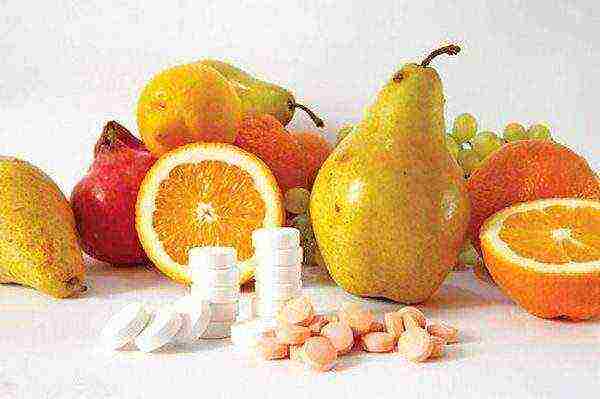
Potato application
In the modern world, potatoes used not only for food, including the production of alcoholic beverages.
Among hundreds of other uses for potatoes:
- starch is used in the food industry for the production of thickeners, in the textile industry for adhesives and for the manufacture of paper and boards;
- researched for the production of polylactic acid for use in the manufacture of plastic products; starch serves as a base for biodegradable packaging;
- potato skins mixed with honey - folk remedy for burns in India. The country's burn centers are experimenting with a thin outer layer of tubers to treat burns;
- researched by scientists due to its clonal nature, consistent tissue parenchyma, low metabolic activity.
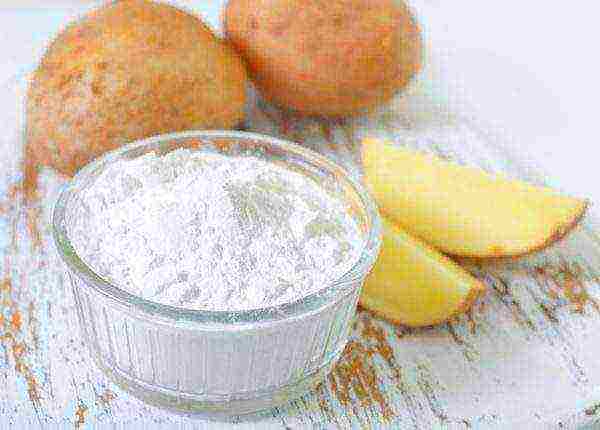
Cultural history in Europe and Russia
The Spanish conquistadors first encountered potatoes when they arrived in Peru in 1532 in search of gold. After the potato arrived in Spain in 1570, several Spanish farmers began to grow it on a small scale, mainly as food for livestock.
From Spain, potatoes spread to Italy and other European countries in the late 1500s, although initially, he did not receive a warm welcome from the people.
In northern Europe, potatoes were grown in botanical gardens as an exotic novelty. The introduction of potatoes in Russia is traditionally associated with the name of Peter the Great.
According to another version, Catherine the Great ordered the people to start cultivating tubers, but the majority of the people, supported by the Orthodox Church, which claimed that potatoes were not mentioned in the Bible, ignored this instruction.
Until 1850, potatoes were not widely grown in Russia.until Nicholas I began to carry out the order of the empress.
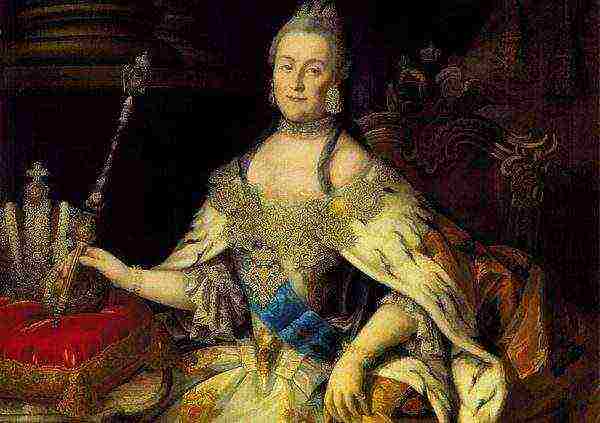
Potatoes are an important plant model. It has several biological characteristics that make it an attractive model to study. Like many other important crops, potatoes are polyploid. The effect of polyploidy on crop production remains to be determined, but its prevalence in crops offers certain benefits.
